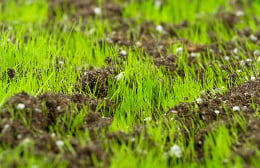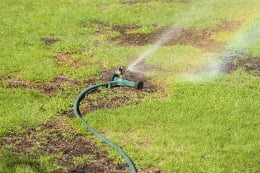11 Tips for Spring Grass Reseeding

When your lawn revives in the spring, it may not be as thick or green as you would like. Even if you are mowing, fertilizing, and watering your lawn properly, a yearly reseeding might be necessary to keep it in tip-top shape. Here are ten easy steps to help you with the reseeding process.
- Don’t jump the gun and plant before the temperatures are right. Cool-season grass seeds will germinate when soil temperatures are between 55 and 65°F, and warm-season grass seed will germinate when soil temperatures are between 70 and 80°F. Your lawn should be actively growing when you reseed, and there shouldn’t be any danger of another frost. When these temperatures occur will depend on where you live, so make sure you are listening to weather reports and relying on an accurate thermometer.
- You don’t just have to sit around and wait for the timing to be right. Make sure that you know a) what kind of seed you are planting, and b) what kind of soil you are planting them in. Be sure to choose a product that has a high live seed percentage. Choosing a different grass variety or even a different species to reseed with will increase your lawn’s tolerance for stress.
- Consult your most recent soil test or have one done. If the pH level is too acidic for good grass growth, now is the time to do a lime application.
- Before you grow tender new grass, you should get all of the stressful maintenance practices out of the way. So if your lawn is growing on a thick layer of thatch or compacted soil, take care of it with a vertical mower or a core aerator. Give the lawn a couple of days to recuperate before you begin reseeding.
- Remove anything that makes the ground uneven: sticks, stones, leaves, etc.
- Using a straight rake, rake across the lawn to get the soil loose and ready for new seeds.
- Check to seeing what the reseeding rate is on your bag of seed—not the seeding rate! It shouldn’t be over 3 or 4 lbs. per 1,000 sq. ft. of lawn. You can sow them by hand or use a drop spreader. For ensured evenness, spread half in a horizontal direction across the lawn, and the other half in a vertical direction.
 Rake the ground again (lightly this time), and run a half-filled roller across the lawn to help firm up the soil.
Rake the ground again (lightly this time), and run a half-filled roller across the lawn to help firm up the soil.- Spread a light layer of soil, peat moss, or other compost on top of the lawn. It shouldn’t be thicker than ¼”; otherwise seed germination will be reduced.
- Apply a light, slow-release fertilizer with more phosphorus. Phosphorus is an element that helps new lawns become established.
- Keep the soil moist through brief and light irrigations, as many as two to five per day. Be patient! Some grass seed, like perennial ryegrass take only ten days to germinate. Others, like the notoriously slow Kentucky bluegrass, can take up to thirty days. Don’t let the soil dry out until you see the new grass growing. Once that goal is achieved, you can start letting the soil dry out between deeper irrigations. Wait to mow the lawn until the grass is 1 ½ to 2” long.
